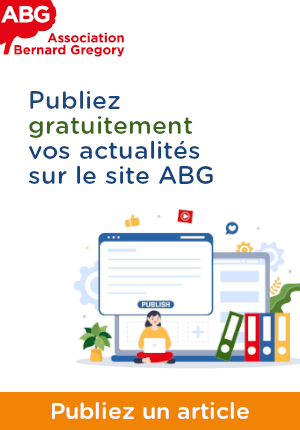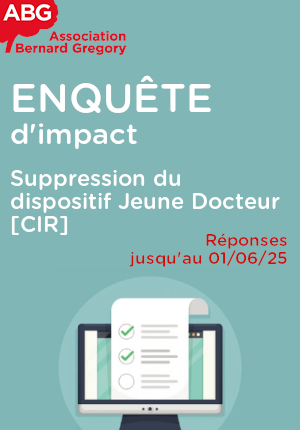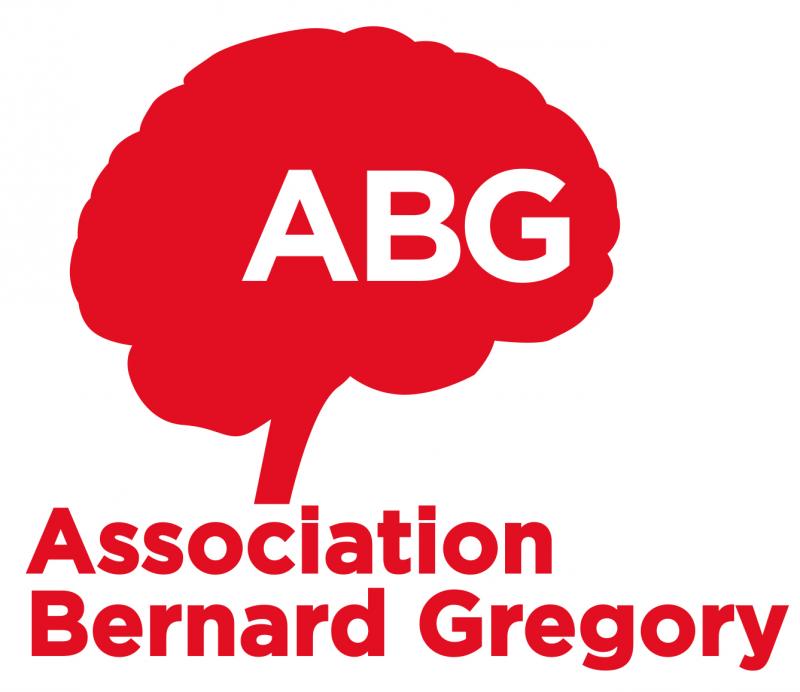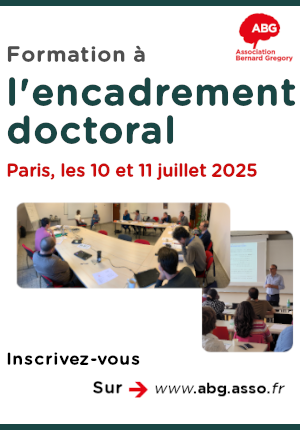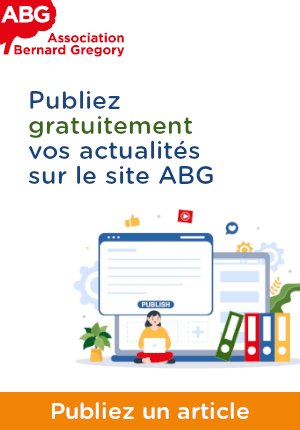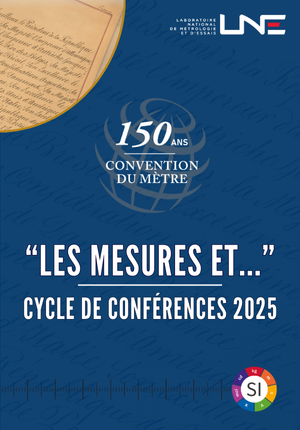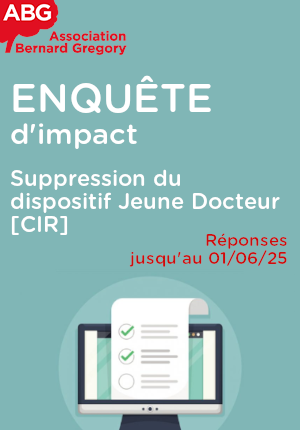Environnement d'apprentissage avec IA pour la conceptualisation de l'axe gradué // IA enhanced learning environment for the conceptualisation of graduated axis
|
ABG-132216
ADUM-66292 |
Thesis topic | |
| 2025-05-27 |
Université Grenoble Alpes
Saint-Martin-d'Hères - Auvergne-Rhône-Alpes - France
Environnement d'apprentissage avec IA pour la conceptualisation de l'axe gradué // IA enhanced learning environment for the conceptualisation of graduated axis
- Mathematics
EIAH, didactique des mathématiques, axe gradué, conception, Intelligence artificielle
Technology-enhanced learning environment, Mathematic education, graduated axis, conception, Artificial Intelligence
Technology-enhanced learning environment, Mathematic education, graduated axis, conception, Artificial Intelligence
Topic description
L'axe gradué est un outil essentiel en mathématiques, utilisé tout au long de la scolarité pour représenter graphiquement et spatialement les nombres. Malgré son importance, de nombreux élèves éprouvent des difficultés à le comprendre et à l'utiliser. Des difficultés sont également observées chez les enseignants en formation initiale. Une meilleure compréhension de la notion d'axe gradué, de ses propriétés et de son rôle dans l'apprentissage des mathématiques est nécessaire.
La thèse proposée vise à répondre à ce besoin en modélisant (avec le cadre théorique cK¢ de Balacheff (1995, 2013)) les principales conceptualisations de l'axe gradué chez les élèves de l'école primaire et en proposant des éléments clés pour un enseignement adapté à l'évolution de ces conceptualisations. Ce type de modèle permet alors de concevoir des situations d'apprentissage, notamment avec des environnements informatiques.
La recherche s'appuiera sur les résultats du projet CESALIN (2022-2024), qui a évalué les apprentissages d'élèves de cycle 2 résultant d'une séquence d'enseignement de l'axe gradué. Les résultats sont positifs pour les tâches directement liées à l'apprentissage de l'axe gradué, mais le travail n'a pas consisté à décrire les procédures et stratégies des élèves, nécessaires pour une modélisation des connaissances avec cK¢. Une recherche dans le cadre d'un stage de master a poursuivi ce premier travail par la caractérisation de trois conceptions distinctes de l'organisation spatiale des nombres chez les élèves la conception d'un protocole pour leur diagnostic. Ces travaux ouvrent la voie à une recherche plus systématique des principales conceptions utiles pour décrire et comprendre la connaissance de l'axe gradué par les élèves de primaire.
Le second objectif de la thèse consiste à identifier et proposer des éléments clés d'un enseignement de l'axe gradué. Il sera traité par la conception et l'évaluation d'un assistant pédagogique basé sur l'intelligence artificielle pour les enseignants et les élèves. Développée dans le cadre d'un partenariat d'innovation avec le MENJ, la solution proposée a l'originalité de prévoir le passage d'un support tangible à un support informatisé et vice-versa, de façon fluide, via diverses modalités de capture et de reconnaissance rendues possibles par l'IA. La pertinence et la validité de la modélisation des connaissances de l'axe gradué seront évaluées grâce à leur implémentation dans les situations d'apprentissage avec l'assistant pédagogique et leur test auprès d'élèves et d'enseignants.
En résumé, cette thèse en didactique des mathématiques propose de modéliser la connaissance relative à la notion d'axe gradué et d'établir la validité et la pertinence de ce modèle grâce à son implémentation dans un assistant pédagogique basé sur l'IA.
------------------------------------------------------------------------------------------------------------------------------------------------------------------------
------------------------------------------------------------------------------------------------------------------------------------------------------------------------
The graduated axis is an essential tool in mathematics, used throughout school to represent numbers graphically and spatially. Despite its importance, many students have difficulty understanding and using it. Difficulties are also observed among pre-service teachers. A better understanding of the notion of the graduated axis, its properties and its role in learning mathematics is needed.
The proposed thesis aims to address this need by modeling (with Balacheff's (1995, 2013) cK¢ theoretical framework) the main conceptualizations of the graduated axis of elementary school students and proposing key elements for teaching adapted to the evolution of these conceptualizations. This type of model can then be used to design learning situations, particularly with technological environments.
The research will draw on the results of the CESALIN project (2022-2024), which evaluated the learning of primary school pupils resulting from a graduated axis teaching sequence. The results are positive for tasks directly linked to learning of the graduated axis, but the work did not involve describing the pupils' procedures and strategies, which are necessary for modeling knowledge with cK¢. A master degree research continued this initial work, characterizing three distinct pupils' conceptions of the spatial organization of numbers and designing a protocol for their diagnosis. This work paves the way for a more systematic investigation of the main conceptions useful for describing and understanding primary school pupils' knowledge of the graduated axis.
The second aim of the thesis is to identify and propose key elements for teaching the graduated axis. This will be addressed through the design and evaluation of an artificial intelligence-based teaching assistant for teachers and pupils. Developed within the framework of an innovation partnership with the MENJ, the proposed solution has the originality of providing for the transition from a tangible medium to a computerized one and vice-versa, in a fluid manner, via various capture and recognition modalities made possible by AI. The relevance and validity of the graduated axis knowledge modeling will be assessed through implementation in learning situations with the teaching assistant and testing with students and teachers.
In summary, this thesis in the field of mathematic education proposes to model knowledge relating to the notion of graduated axis and to establish the validity and relevance of this model through its implementation in an AI-based pedagogical assistant.
------------------------------------------------------------------------------------------------------------------------------------------------------------------------
------------------------------------------------------------------------------------------------------------------------------------------------------------------------
Début de la thèse : 01/10/2025
La thèse proposée vise à répondre à ce besoin en modélisant (avec le cadre théorique cK¢ de Balacheff (1995, 2013)) les principales conceptualisations de l'axe gradué chez les élèves de l'école primaire et en proposant des éléments clés pour un enseignement adapté à l'évolution de ces conceptualisations. Ce type de modèle permet alors de concevoir des situations d'apprentissage, notamment avec des environnements informatiques.
La recherche s'appuiera sur les résultats du projet CESALIN (2022-2024), qui a évalué les apprentissages d'élèves de cycle 2 résultant d'une séquence d'enseignement de l'axe gradué. Les résultats sont positifs pour les tâches directement liées à l'apprentissage de l'axe gradué, mais le travail n'a pas consisté à décrire les procédures et stratégies des élèves, nécessaires pour une modélisation des connaissances avec cK¢. Une recherche dans le cadre d'un stage de master a poursuivi ce premier travail par la caractérisation de trois conceptions distinctes de l'organisation spatiale des nombres chez les élèves la conception d'un protocole pour leur diagnostic. Ces travaux ouvrent la voie à une recherche plus systématique des principales conceptions utiles pour décrire et comprendre la connaissance de l'axe gradué par les élèves de primaire.
Le second objectif de la thèse consiste à identifier et proposer des éléments clés d'un enseignement de l'axe gradué. Il sera traité par la conception et l'évaluation d'un assistant pédagogique basé sur l'intelligence artificielle pour les enseignants et les élèves. Développée dans le cadre d'un partenariat d'innovation avec le MENJ, la solution proposée a l'originalité de prévoir le passage d'un support tangible à un support informatisé et vice-versa, de façon fluide, via diverses modalités de capture et de reconnaissance rendues possibles par l'IA. La pertinence et la validité de la modélisation des connaissances de l'axe gradué seront évaluées grâce à leur implémentation dans les situations d'apprentissage avec l'assistant pédagogique et leur test auprès d'élèves et d'enseignants.
En résumé, cette thèse en didactique des mathématiques propose de modéliser la connaissance relative à la notion d'axe gradué et d'établir la validité et la pertinence de ce modèle grâce à son implémentation dans un assistant pédagogique basé sur l'IA.
------------------------------------------------------------------------------------------------------------------------------------------------------------------------
------------------------------------------------------------------------------------------------------------------------------------------------------------------------
The graduated axis is an essential tool in mathematics, used throughout school to represent numbers graphically and spatially. Despite its importance, many students have difficulty understanding and using it. Difficulties are also observed among pre-service teachers. A better understanding of the notion of the graduated axis, its properties and its role in learning mathematics is needed.
The proposed thesis aims to address this need by modeling (with Balacheff's (1995, 2013) cK¢ theoretical framework) the main conceptualizations of the graduated axis of elementary school students and proposing key elements for teaching adapted to the evolution of these conceptualizations. This type of model can then be used to design learning situations, particularly with technological environments.
The research will draw on the results of the CESALIN project (2022-2024), which evaluated the learning of primary school pupils resulting from a graduated axis teaching sequence. The results are positive for tasks directly linked to learning of the graduated axis, but the work did not involve describing the pupils' procedures and strategies, which are necessary for modeling knowledge with cK¢. A master degree research continued this initial work, characterizing three distinct pupils' conceptions of the spatial organization of numbers and designing a protocol for their diagnosis. This work paves the way for a more systematic investigation of the main conceptions useful for describing and understanding primary school pupils' knowledge of the graduated axis.
The second aim of the thesis is to identify and propose key elements for teaching the graduated axis. This will be addressed through the design and evaluation of an artificial intelligence-based teaching assistant for teachers and pupils. Developed within the framework of an innovation partnership with the MENJ, the proposed solution has the originality of providing for the transition from a tangible medium to a computerized one and vice-versa, in a fluid manner, via various capture and recognition modalities made possible by AI. The relevance and validity of the graduated axis knowledge modeling will be assessed through implementation in learning situations with the teaching assistant and testing with students and teachers.
In summary, this thesis in the field of mathematic education proposes to model knowledge relating to the notion of graduated axis and to establish the validity and relevance of this model through its implementation in an AI-based pedagogical assistant.
------------------------------------------------------------------------------------------------------------------------------------------------------------------------
------------------------------------------------------------------------------------------------------------------------------------------------------------------------
Début de la thèse : 01/10/2025
Funding category
Funding further details
Concours allocations
Presentation of host institution and host laboratory
Université Grenoble Alpes
Institution awarding doctoral degree
Université Grenoble Alpes
Graduate school
217 MSTII - Mathématiques, Sciences et technologies de l'information, Informatique
Candidate's profile
Formation en mathématiques au niveau de l'enseignement supérieur (diplôme niveau licence en mathématiques)
Formation en didactique des mathématiques (exemple master PIF)
Compétences de théorisation et de rédaction.
Sens de l'organisation et compétences relationnelles pour interagir avec des élèves et des enseignants.
Bachelor's degree in mathematics Master's degree in mathematic didactic or mathematic education Theorizing and writing skills. Organizational and interpersonal skills to interact with students and teachers.
Bachelor's degree in mathematics Master's degree in mathematic didactic or mathematic education Theorizing and writing skills. Organizational and interpersonal skills to interact with students and teachers.
2025-06-09
Apply
Close
Vous avez déjà un compte ?
Nouvel utilisateur ?
More information about ABG?
Get ABG’s monthly newsletters including news, job offers, grants & fellowships and a selection of relevant events…
Discover our members
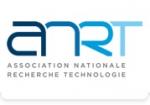 ANRT
ANRT  SUEZ
SUEZ  TotalEnergies
TotalEnergies  ONERA - The French Aerospace Lab
ONERA - The French Aerospace Lab  Nokia Bell Labs France
Nokia Bell Labs France  Groupe AFNOR - Association française de normalisation
Groupe AFNOR - Association française de normalisation  CESI
CESI  Tecknowmetrix
Tecknowmetrix  Laboratoire National de Métrologie et d'Essais - LNE
Laboratoire National de Métrologie et d'Essais - LNE  Institut Sup'biotech de Paris
Institut Sup'biotech de Paris 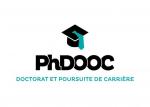 PhDOOC
PhDOOC  Ifremer
Ifremer  MabDesign
MabDesign  MabDesign
MabDesign 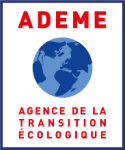 ADEME
ADEME  Généthon
Généthon  ASNR - Autorité de sûreté nucléaire et de radioprotection - Siège
ASNR - Autorité de sûreté nucléaire et de radioprotection - Siège  Aérocentre, Pôle d'excellence régional
Aérocentre, Pôle d'excellence régional  CASDEN
CASDEN


